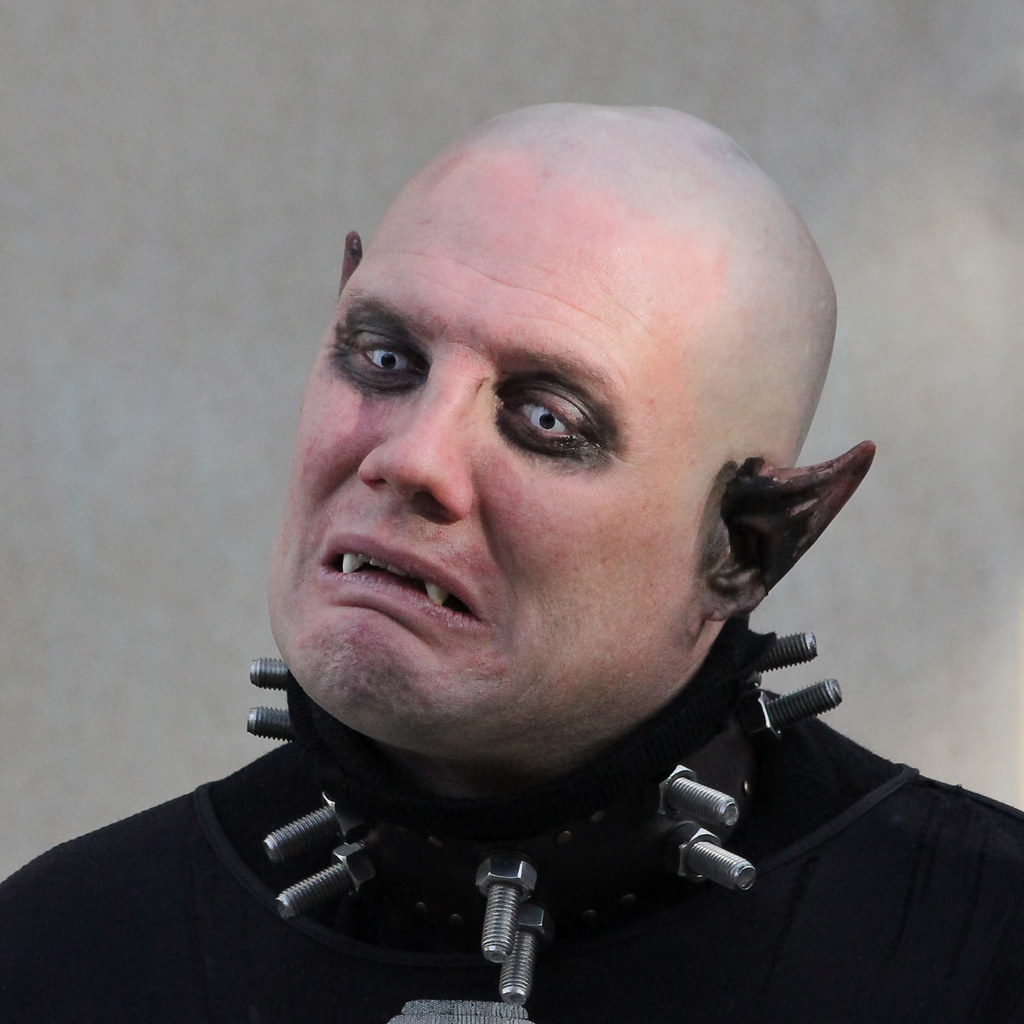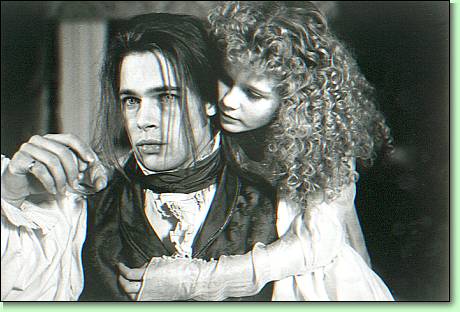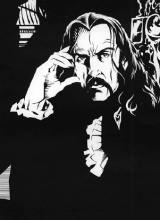
Pity the fate of the humble vampire. Once monsters as fearsome as any others, they have been so overwhelmed by pop-culture overexposure that it's become extremely difficult to take them seriously any more. Imagine a scene in which your villain reveals his inhuman nature: in which he tears open his clothes to reveal that he's been dead all along, or that he's made from stitched-together human corpses, or that he's some kind of freakish mutant, or that he's actually just a crude automaton with a preserved human head nailed to its shoulders. Now imagine that scene replaced with the revelation that he's actually... a vampire! You won't get any reactions of shock. You'll just get bad Eastern European accents, jokes about garlic sausages, and PCs asking him if he evah dreenks... vine?
Most readers of this blog will probably be aware of the Vampire: the Masquerade RPG, which came out in 1991 - a simpler time, when vampires hadn't been quite so done to death, and vampire movies still looked like Near Dark rather than Underworld: Blood Wars. Because it was a whole game which was just about vampires, it swiftly came to resemble one of those weird island ecosystems in which variants of a single original species end up occupying a whole range of ecological niches usually filled by very different animals: so you had zombie-vampires, werewolf-vampires, wizard-vampires, snake-vampires, gargoyle-vampires, and so on, as successive writers added more and more variants to the game. Given that the fact they were vampires was often absolutely the least interesting thing about them, and that these days it's is probably an active liability rather than an asset, I'd suggest that in many games these vampire variants would actually be more useful if you just removed the vampire element entirely. Make them into cults, or mutants, or secret societies. Make them into creepy lineages of black magicians. Make them into the remnants of weird abhuman precursor races. Make them into the warped products of deranged scientific experiments. Make them anything except more fucking vampires.
 |
| 'I was cool once, right, Claudia? Tell me I used to be cool...' |
Once you rid them of vampirism, with all its attendant baggage, you suddenly have a whole range of weird, creepy groups with weird, creepy powers, ready to sprinkle into the dark corners of your campaign world. Here, for example, are twenty clans and bloodlines from Vampire: the Masquerade and Vampire: the Requiem, rewritten simply as almost-human families with some unusual inherited gifts. Just change the names and the clothes, and your players will probably never even realise the original source...
1: Brujah. Shattered remnants of a family which once gained power over time itself. Their time-magic is lost, now, and all that remains is an instinctive knack for localised time dilation, which makes them appear to be moving in jerky fast-forward when used. They have almost no control over their emotions, and are prone to rages and tantrums, which makes them easy to manipulate (and which is probably the reason their original achievements ended up falling apart.) Prone to bouts of melancholic self-pity about the largely-imaginary glories they once possessed.
2: Gangrel. A tribe of weird, feral wanderers, with night vision and savage teeth and claws like those of wild beasts. Brutal predators who prey upon animals and human alike, and are fearsomely difficult to kill. Nomadic. As they get older their bodies become more and more bestial, developing fur, tails, muzzles, and other marks of their animalistic nature.

3: Nosferatu. A lineage of deformed creatures who shun the light of day, hiding their hideous faces beneath the earth. Their twisted bodies are enormously strong, and they possess an instinctive knack for stealth, which helps them to remain hidden from a surface world which mostly despises and loathes them. Avid collectors of secrets.
4: Toreador. This family possess enhanced reflexes, heightened senses, and low-level telepathy. They tend to become fixated upon whatever they happen to find beautiful, and are quite irrational in their pursuit of it. They admire art but are incapable of genuine creativity, and mostly have to settle for simply collecting the objects and people with whom they become obsessed. Egotistical and often narcissistic, they pride themselves on being muses and patrons rather than the parasites they really are.
5: Ventrue. This family possess minor but instinctive mind-manipulation powers, which make everyone regard them as impressive and authoritative regardless of what they're actually doing. They are totally convinced that this gift makes them the natural rulers of the world, inherently superior to everyone else. Love to set themselves up as powers behind the throne within established authority structures, and then proceed to engage in interminable bouts of mutual congratulation about how terribly clever they are. Their bodies are strangely resilient and difficult to damage, which means that once they have infested a given organisation they are, like cockroaches, annoyingly difficult to get rid of.
6: Malkavian. Members of this bloodline are afflicted with a variety of hereditary insanities, but are also prone to weird visions and cryptic insights, and linked to one another by some kind of strange telepathic network which they seem to be unable to detach themselves from. Their lunacy is infectious, and anyone meeting their gaze has a chance of being struck down with temporary madness. They are sometimes kept around as seers, usually blindfolded, but their kinsmen always know where to find them and will inevitably mount a rescue attempt sooner or later.

7: Tremere. This clan possess the gifts of telekinesis and the ability to conjure heat and flame; their favourite combat technique is to use this latter ability on the inside of an enemy's body, cooking them alive from the inside out. They are bound together in a strict hierarchy in which the young are expected to obey their elders without question, with loyalty enforced through creepy rituals and brutal punishment of the disobedient. Fraternisation with outsiders is heavily discouraged.
8: Lasombra. This lineage have animate shadows, which they can control mentally, causing them to grow into great palls of darkness which shut out all light. Once a Lasombra's shadow has swallowed you, tendrils of freezing darkness will reach out of it and begin to rip you apart. The eldest of them are able to merge with their own shadows, becoming monsters of icy, inky liquid blackness, desperately difficult to destroy except with fire. They gather in witchy covens, and delight in spreading terror among nearby populations.
9: Giovanni. A family of necromancers with a dark reputation for cannibalism, necrophilia and incest. Fantastically wealthy due to their involvement in crime and finance. They make extensive use of enslaved ghosts to spy upon their rivals, which grants them a substantial edge in both fields of business.

10: Tzimisce. A tribe with horrible flesh-sculpting powers, able - with concentration - to warp living flesh and bone as though it was wet clay. They sculpt themselves into bizarre and monstrous forms to intimidate their enemies in battle, and are served by warped humans and animals whom they twist into new forms to better fit the functions desired of them. Their most horrific creations are composite beasts made from many creatures melded together into towering monsters, clumsy but strong, and very difficult to kill for as long as any of their dozens of brains or hearts remain intact.
11: Settites. This clan of snake-worshippers possess hypnotic eyes, scaly skin, and long, forked, razor-sharp tongues, capable of delivering sudden stab wounds and opening arteries from over a foot away. They use the power of their mesmeric gaze to build cults around themselves, revering ancient serpent-deities whom they claim will one day free the world from the hypocritical rule of the gods. In theory, their doctrine of undermining all certainties is supposed to set their followers free; in practise, it mostly leaves their cultists totally adrift and desperately dependent upon their Settite masters. Their cult is banned in all civilised nations.
12: Baali. A tribe of demon-worshippers, capable of inspiring blank terror in their victims, sensing their secret weaknesses, and summoning black flames from the void. Where they dwell the land grows barren, and they are attended by clouds of stinging flies. The presence of genuine holiness fills them with hysterical loathing and dread.
13: Cappadocians. A cursed family marked by their bizarre, corpselike appearance, their grey skin pulled tightly across their over-prominent bones. Believed to be unlucky, and shunned accordingly, they have withdrawn from the world to study the mysteries of life and death in secret. They are masters of divinatory necromancy, specialising in the interrogation of spirits and divination by means of 'casting the bones'.
14: Blood Brothers. Members of this clan have an extremely strong family resemblance, to the point where they are continually mistaken for one another by outsiders. (The fact that their rather masculine-looking womenfolk are constantly having sets of identical twins and triplets doesn't help much.) They are linked together by an instinctive, low-level telepathy, which allows them to sense one another's general position and emotional state, and have a very weak sense of individual identity. Injured Brothers can induce a state of rapid healing by drinking one another's blood, and if one loses a limb or an organ then a replacement taken from another Brother will swiftly engraft itself in place if the swap is made quickly enough.
15: Caporetti. Descended from soldiers buried beneath rock and ice when their mountainside battlefields were swept by avalanches, this weird, burrowing clan has acquired the chill of the icy caves in which they live. Their mere presence turns the air chill, and their touch freezes like death.

16: Galloi. A family of blood magicians, who gain youth, strength, and a weird androgynous beauty from regular immersions in human blood. Their victims don't need to die, but they do need a lot of blood, and they thus use their power and glamour to place themselves at the heart of spurious blood cults which revere them as divinities. Their cancelled years will rapidly catch up with them if their immersions are suspended.
17: Macellari. A clan of obese cannibal gluttons, who are descended from ancient nobility and use their immense wealth to indulge their horrible habits in secret. They possess an instinctive mastery over animals, which they use to breed horses of incredible strength and size - the only beasts capable of carrying them. They are capable of absorbing instinctive knowledge from the brains of those they consume, and in emergencies they can vomit up great gouts of acidic bile from their distended stomachs.
18: Melissidae. A family which has entered into a bizarre symbiosis with a specially-bred form of bee-like insects, which build their fleshy hives within the interiors of their bloated bodies. The Melissidae possess a mental link with the insect swarms which inhabit them, and are capable of sending them out as scouts, or as breathing them forth in enormous stinging swarms.
19: Baddacelli. This family are born blind, and navigate by means of their hearing, which is superhumanly acute. They are expert mimics, capable of imitating any voice or sound, and in emergencies they can unleash ear-splitting shrieks to stun and deafen their enemies. Most dwell beneath the earth, in darkness, where their lack of need for light is easily turned to their advantage.
20: Mnemosyne. Members of this lineage have the uncanny ability to steal and manipulate memories with a touch. Every memory they take or change from someone else, however, is absorbed into their own minds, recalled as though it had actually happened to them: and as a result, the more they use it, the more confused and fragmented their own minds and identities become. Their family history is an impossible tangle of things that actually happened to them and things that they took the memories of from other people, so hopelessly garbled together by age, time, and madness that none of them can even begin to work out where the real memories end and the stolen ones begin.

You've managed to encapsulate both exactly why I'm not a big fan of VtM, but also pulled the "take something you don't like and make it something you do like" switcheroo. This is some great stuff.
ReplyDeleteFascinating stuff that I'm sure to use!
ReplyDeleteNah, the problem with both Masquerade and Requiem is exactly the same (even when you remember that Requiem developers tried not to repeat it) - almost nobody tried to go deeper with basic clans and sects of both Vampire settings, everyone - sooner o later - was going wider and wider. Add some exotic, ultra-powerful (or ultra-dumb, often both at the same time) Discipline and wrap around it whole concept of new clan/bloodline (Assamites, Tzimisce, Setites etc.). In one of his reviews Mark Rein-Hagen openly admitted that he doesn't really care about most things above seven original clans of Masquerade and that he is unable to say anything in their defense (it is hard for him to say anything about them). Reason for that is 'cause original 7 were designed to work like clockwork mechanism (even if it is hard to see after 26 years) and he felt nothing more was needed.
ReplyDeleteNarrator was in need of some sick, new and strange vampire? Fine, let him create it as NPC (that's how Tzimisce and most Independent clans were created - as NPC's, without clear mechanics behind their powers). Each new developer tried to leave something in the system for whitch he will be remembered. And so we have clans of fairy-vampires, clans of sickness-vampires, d12 power hungry vampire clans, etc. Today I see clearly that following Rein-Hagen intuition and staying with only seven clans is a huge improvement for this game.
Going back to the roots is always refreshing, isnt't it?